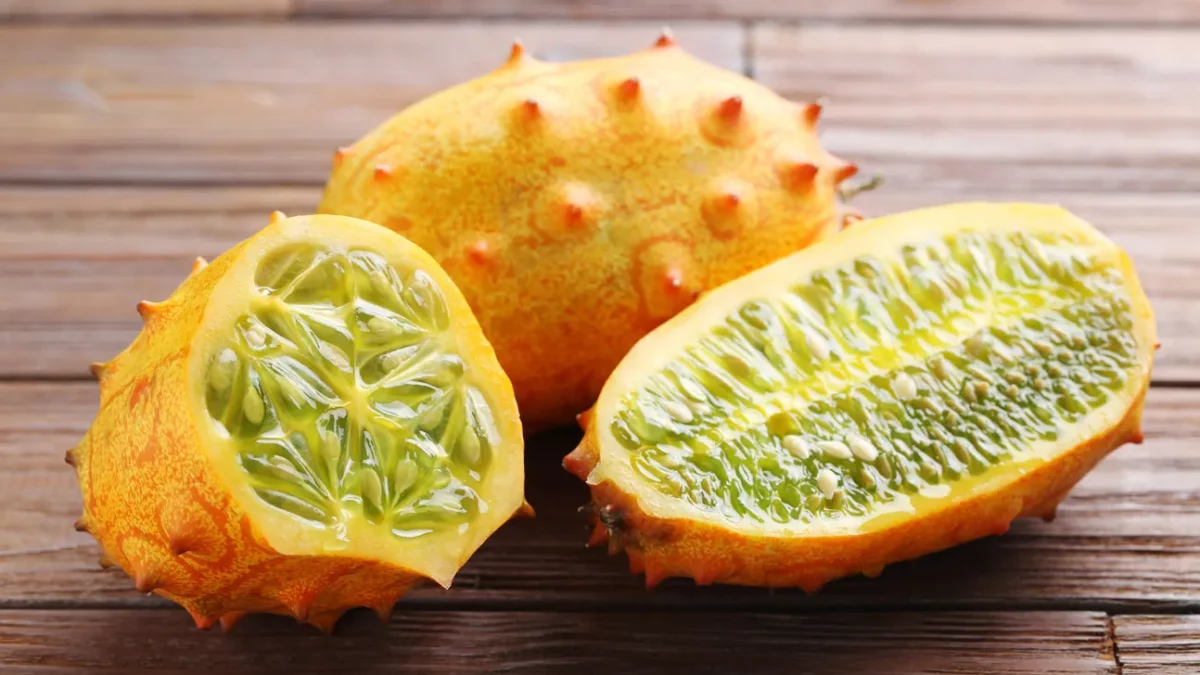
Understanding Kiwano (Horned Melon)
What is Kiwano?
Kiwano, scientifically known as Cucumis metuliferus, is a member of the Cucurbitaceae family, which includes cucumbers, melons, and squash. It is characterized by its oblong shape, vibrant orange skin covered in spikes or horns, and gelatinous green flesh filled with edible seeds.
Nutritional Profile of Kiwano
Kiwano is a nutrient-dense fruit that offers a range of vitamins, minerals, antioxidants, and fiber. It is low in calories and carbohydrates, making it a suitable option for those looking to add variety to their diet without compromising their nutritional goals.
Benefits of Kiwano (Horned Melon)
Rich in Vitamins and Minerals
Kiwano is a good source of vitamins C and A, which are essential for immune function, skin health, and vision. It also contains potassium, magnesium, and iron, important minerals that support overall health and well-being.
Antioxidant Properties
The vibrant orange color of kiwano is indicative of its antioxidant content, particularly beta-carotene and vitamin C. These antioxidants help protect cells from damage caused by free radicals and may reduce the risk of chronic diseases such as heart disease and cancer.
Hydration
With its high water content and refreshing flavor, kiwano is an excellent hydrating snack option, especially during hot weather or after physical activity. Staying hydrated is essential for maintaining optimal health and supporting bodily functions.
Digestive Health
The fiber content in kiwano promotes healthy digestion by adding bulk to stool, preventing constipation, and supporting regular bowel movements. Including fiber-rich foods like kiwano in your diet can help maintain a healthy digestive system.
Skin Health
The vitamin C and antioxidants found in kiwano may contribute to healthy skin by promoting collagen production, reducing oxidative stress, and protecting against UV damage. Consuming kiwano as part of a balanced diet may help maintain youthful and radiant skin.
Weight Management
Due to its low calorie and carbohydrate content, kiwano can be a satisfying and nutritious snack option for those looking to manage their weight or incorporate more fruits into their diet. Its high water and fiber content can help promote feelings of fullness and satiety.
Versatile Culinary Ingredient
Kiwano’s unique flavor and texture make it a versatile ingredient in both sweet and savory dishes. It can be used in salads, salsas, smoothies, desserts, and cocktails to add a pop of color and tropical flair to your culinary creations.
How to Eat Kiwano (Horned Melon)
Ripe and Ready
Choose a kiwano that is ripe and ready to eat by looking for one with bright orange skin and firm, but slightly yielding, spikes. Avoid fruits with soft spots or moldy areas.
Slice and Scoop
To eat kiwano, slice it in half lengthwise with a sharp knife and use a spoon to scoop out the gelatinous green flesh and seeds. The seeds are edible and add a crunchy texture to the fruit.
Enjoy Fresh
Enjoy kiwano fresh as a refreshing snack on its own or add it to fruit salads, yogurt parfaits, or smoothie bowls for a tropical twist. Its mild flavor pairs well with a variety of other fruits and ingredients.
Use in Recipes
Incorporate kiwano into recipes for salads, salsas, chutneys, cocktails, and desserts for a burst of color and flavor. Its unique appearance and texture can add visual interest to dishes and elevate their presentation.
Experiment with Flavors
Experiment with different flavor combinations by combining kiwano with ingredients like lime, mint, coconut, ginger, or chili for a refreshing and exotic culinary experience.
FAQs
Is kiwano high in sugar?
Kiwano has a relatively low sugar content compared to other fruits, making it a suitable option for those monitoring their sugar intake. It contains approximately 4 grams of sugar per 100 grams of fruit.
Can you eat the seeds of kiwano?
Yes, the seeds of kiwano are edible and can be consumed along with the gelatinous green flesh. They add a crunchy texture to the fruit and are rich in fiber, protein, and healthy fats.
Is kiwano good for weight loss?
Kiwano can be a beneficial addition to a weight loss diet due to its low calorie and carbohydrate content, high water and fiber content, and potential to promote feelings of fullness and satiety.
How should kiwano be stored?
Kiwano should be stored at room temperature until ripe, then refrigerated to extend its shelf life. Once cut, store any leftover kiwano in an airtight container in the refrigerator and consume it within a few days.
Can you freeze kiwano?
Yes, kiwano can be frozen for longer-term storage. Cut the fruit in half, scoop out the flesh and seeds, and freeze the pulp in an airtight container or freezer bag for up to three months. Thaw before using.
Are there any allergic reactions associated with kiwano?
While allergic reactions to kiwano are rare, some individuals may experience allergic symptoms such as itching, swelling, or hives after consuming the fruit. If you have a known allergy to cucumbers or melons, consult with a healthcare professional before trying kiwano.
Is kiwano a sustainable fruit?
Kiwano is considered a sustainable fruit due to its ability to thrive in diverse climates, low water requirements, and minimal environmental impact compared to other crops. It is also resistant to pests and diseases, reducing the need for pesticides and herbicides.
Conclusion
Kiwano, or horned melon, is a unique and nutritious fruit that offers a range of potential health benefits. With its rich vitamin and mineral content, antioxidant properties, hydrating qualities, and versatility in the kitchen, kiwano can be a refreshing addition to your diet. Whether enjoyed fresh as a snack, incorporated into recipes, or used to add flavor and flair to dishes, kiwano provides a delicious and exotic culinary experience. By understanding its benefits, how to eat it, and common FAQs, you can confidently incorporate kiwano into your lifestyle and enjoy its many advantages.
- The Emotional Damage Caused By Ghosting And How To Cope With It - June 1, 2025
- Retinol Peel Near Dormansland, Surrey - May 31, 2025
- Skin Treatment & Skincare Consultations Near Thornton Heath, Surrey - May 30, 2025


